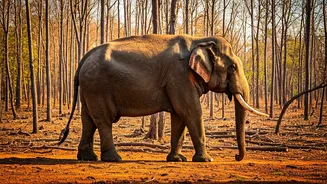Tragic Loss of Life
Recent data from an Assam district shows a distressing trend: four elephants have died in just 20 days. These deaths highlight the intensifying conflict
between humans and elephants. According to Udalguri DFO Mustafa Ali Ahmed, the majority of the recent deaths happened in regions neighboring forests where residents practice paddy cultivation. This situation has escalated to a concerning point, signaling an urgent need to tackle the roots of the problem and prevent future incidents.
Conflict's Core Issues
The main cause of these deaths is the ongoing conflict between elephants and humans. Officials report that the areas for wild elephants' movement are shrinking because of growing encroachments. This intrusion into their natural habitats is leading to more interactions, and unfortunately, conflicts, with humans. As human activities push into elephant territories, the competition for resources intensifies, leading to more confrontations and, tragically, more deaths.
Habitat Encroachment Details
The steady decline of elephant habitats is largely attributed to human activities, specifically encroachment. As communities and agricultural practices extend closer to forest edges, the space available for elephants dwindles. The cultivation of paddy, in particular, poses a risk, drawing elephants towards these areas, thus raising the likelihood of conflict. This encroachment disrupts the natural balance, compelling elephants to interact with humans, often with deadly consequences.
Consequences of Shrinkage
The shrinking of elephant habitats has severe ramifications. It forces elephants to seek out alternative food sources, bringing them closer to human settlements and farmlands. This increases the chances of crop raiding, property damage, and, tragically, incidents of human-elephant conflict. The reduction in habitat also impacts elephant populations' ability to thrive, hindering their access to resources and increasing the pressures they face. Without viable space, elephants struggle to maintain their migratory patterns and sustain their existence.
Addressing the Crisis
Tackling the rising elephant deaths in Assam demands urgent attention and concerted action. It requires a combined approach focused on protecting and preserving elephant habitats. Measures like stricter regulations against encroachment and promoting coexistence are necessary. Encouraging sustainable agricultural practices that minimize interaction, and educating communities about elephant behaviour will be vital. Additionally, there needs to be improved communication and coordination between local authorities, wildlife experts, and communities to implement effective conflict mitigation strategies and safeguard elephant populations.











